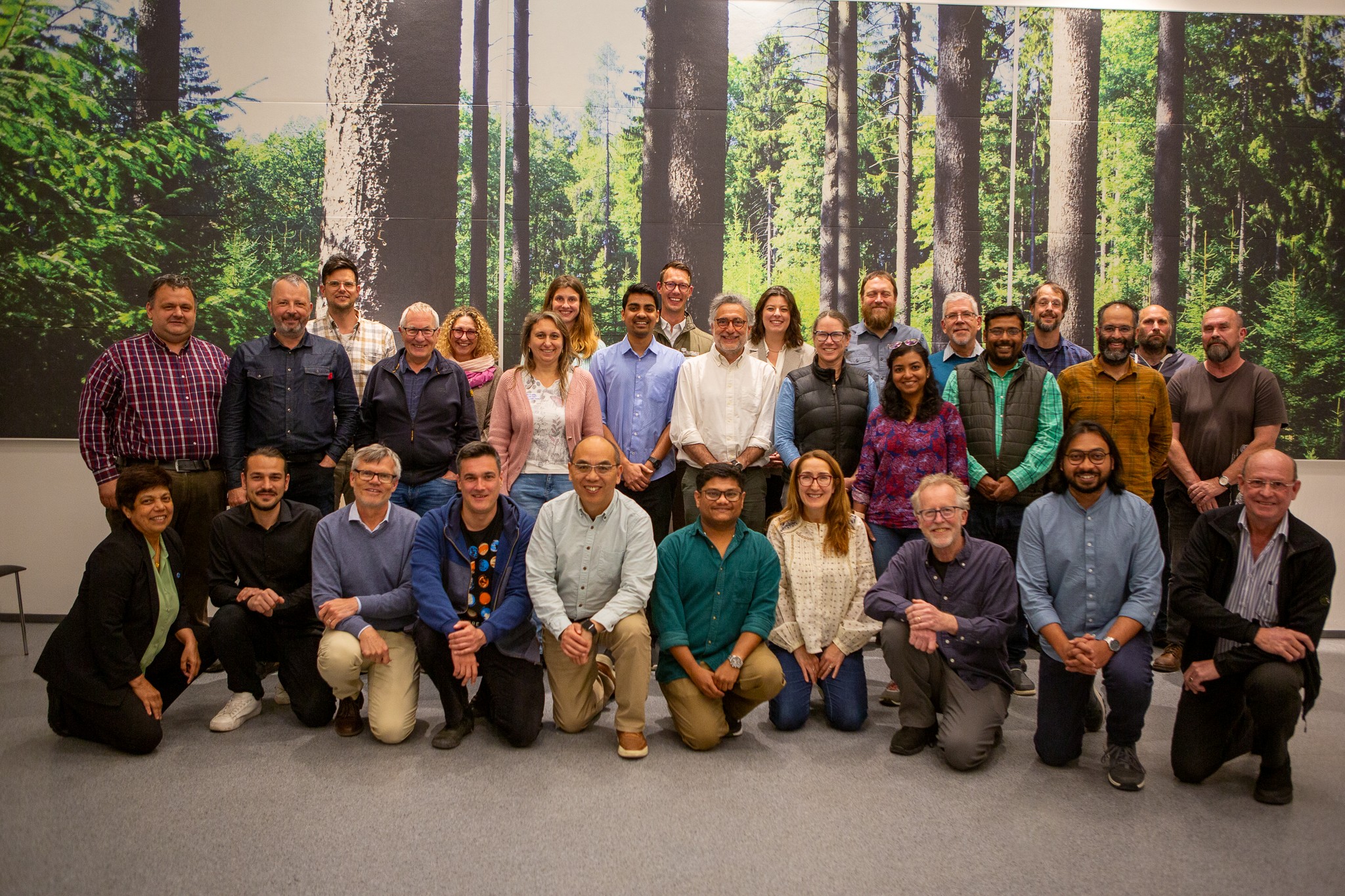INAUGURAL SYMPOSIUM OF THE FOREST INVASION SYNTHESIS CENTRE, PRAGUE
6-8 May 2025
Faculty of Forestry and Wood Sciences, Czech University of Life Sciences Prague
The FISC Inagural Symposium was organized for the purpose of summarizing the current state of scientific knowledge about biological invasions in forests worldwide and seek input from scientific community on the selection of scientific subject areas that should be prioritized by the Centre. The Centre plans to organize collaborative working groups around selected research topics so participants were asked to contribut their expertise and opinions about what subjects would be most useful to pursue.
Presentations:
An interdisiciplinary team of 13 scientists were invited to summarize the state of knowledge on various aspects of the forest invasion problem. These individuals presented information and proposed ideas for new work:
Andrew Liebhold (FISC Chief Scientist), “Overview of the Forest Invasion Synthesis Centre, Prague and objectives of the Symposium". See the talk here: A.M.Liebhold´s symposium talk
Petr Pyšek (Institute of Botany of the Czech Academy of Sciences), “Macroecology of woody plant invasions"
Martin A. Nunez (University of Houston, USA), “Forest tree invasions. See the talk here: M.A. Nunez´s symposium talk
Thomas Wohlgemuth (Swiss Federal Institute for Forest, Snow and Landscape Research WSL, Switzerland), “Role of non-native trees in future European forests" See the talk here: T. Wohlgemuth´s symposium talk
Michael Wingfield (University of Pretoria, South Africa), “Forest health challenges in planted forests”
Eckehard Brockerhoff (Swiss Federal Institute for Forest, Snow and Landscape Research WSL, Switzerland), “Biotic resistance against invasions: Contrasting plant and insect invaders". See the talk here: E. Brockerhoffs´s symposium talk
Alberto Santini (Institute for Sustainable Plant Protection, Italy), “Biogeography of tree pathogen invasions”
Tomáš Hlásny (The Forest Risk Research Centre), "“Forest disturbance monitoring in Europe and recent biotic disturbance trends". See the talk here: T.Hlásny´s symposium talk
Songlin Fei (Purdue University, USA) “Landscape level survey of forest invaders". See the talk here: Songlin Fei´s symposium talk
Kevin Chase (Bartlett Tree Company, Reading, UK), “Invasions in Urban forests"
Christelle Robinet (INRAE, France), “Modelling forest pest invasion risk and management". See the talk here: Christelle Robinet´s symposium talk
Rebeccca Epanchin-Niell (University of Maryland, USA), “Cost-effective forest biosecurity". See the talk here: Rebecca Epanchin-Niell´s symposium talk
Mariella Marzano, Forest Research, UK, “Social aspects of forest invasions and their management"
Recordings of selected presentations will be made available gradually on our website—stay tuned and follow us for updates.
IDEAS FOR WORKING GROUP TOPICS
During brainstorming breakout sessions, participants identified the following ideas for working groups:
· Global Costs of pathogen invasions and future outlook.
· Integrative pest management across plants, insect and pathogen invasions.
· Synthesis of global micrcobial forest invasions – management, status (how many, where, why), outlook etc.
· Global carbon loss due to forest invasions.
· Global synthesis of pathway management loopholes & improvements for an improved pest management.
· The future of live plant trade globalization & its implication for carbon & biodiversity – a robust discussion about risks and necessities of live plant trade.
· Biotic resistance and invasional meltdown.
· Downstream impacts of invasion on keystone species, soil impacts, structural flattening, and cultural, social and economic impacts.
· Identify knowns and unknowns (biology, data availability, biases in taxa of invasives, types of forests, and regions).
· Integrating ecology and economics. There are regional differences on the levels and attitude towards the integration (New Zealand, Brazil, Europe vs. North America).
· How to standardize the impact, ecosystem services.
· Collection of information about species –into a database.
· Climate change, forest decline, and the hidden role of microbes. Develop an updated synthesis on the links between climate change and forest dieback, with a focus on microbial dynamics. Participants emphasized the growing role of endophytes and other components of the tree microbiome—many of which may remain asymptomatic—as potential agents in biological invasions. These hidden organisms, transported globally via plant material and soil, could pose emerging threats to forest health in a changing climate.
· Cooperative biosecurity. Regional plant protection.
· Economic impacts of invasive species. How can we provide data to assist with measuring the impacts…. Invacost…. Social, financial, cultural …. Also how do we think about species that might be beneficial in one context for one set of stakeholders, but then can also be harmful to others or to other stakeholders.
· Global impacts of invasive plants in forests.
· Unauthorized trade – system approach in trade pest reduction. Lots of disciplines and people who have worked on this topic in other contexts (wildlife, drugs, etc) and agency folks who might have the data.
· E-commerce and the unregulated trade of potentially invasive species. Investigating the scale and risks of undeclared online trade in living organisms. By comparing customs and border inspection data with online marketplace activity, it may be possible to reveal gaps in current biosecurity systems. Examples include the ease of purchasing stick insect eggs or other exotic species online for pet breeding, which can lead to accidental releases into the environment. The discussion also called for an overview of countries that maintain alert systems targeting high-risk e-commerce retailers.
· Development of new plant hybrids and potential dangers and distributional impacts.
· Living/cultural/institutional barriers to biosecurity and movement of pest with weapons condition may prevent biosecurity.
· Benefits and pitfall of using nonnative tree invasions in Europe - Climate resilience, impacts of native biodiversity, carbon cycling . hard to fix .using new technologies to make it less of a problem. Social perception.
· Holobiom approach. Association change with nonnative trees.Pros and cons of holobiom invasion. Co-invasions , fungi, insects plants pest pathogens. Invasibility of the environment affected by arrival of new species. Holobiont invasions ~ ecosystem invasion. One health approach: organism is not alone. Microbiome. One health forestry. Invasions change the balance. Microbial aspects of tree invasions . Molecular approach. Genetic engineering.
· Use new technologies to prevent the problem of invasions. Green technologies: Sterile individuals. Nanotechnology. AI. Identify pathways of entry on new species. Understanding the stablishment of new species. Bio surveillance, RNA. Whole genome sequencing. Identification using ADN. eDNA. Emergence technologies that can be used. Can we use new technologies, to help us fight invasions in forests?
· Summarizing successful practices. what has worked and what has not worked. Global approach, what different countries are doing. Doing nothing as a null model?
· Role of hybridization in invasions.
· Drivers of invasion transitions in forest ecosystems.
We would like to sincerely thank all symposium participants for their inspiring contributions and valuable ideas. The breadth and depth of proposed topics reflect the complexity and urgency of forest invasion issues and the importance of interdisciplinary collaboration. As we move forward in shaping the first FISC working groups, we will keep you informed about which of the above challenges we decide to pursue. Stay connected with us as the next phase of collaborative synthesis begins.
The Forest Invasion Synthesis Centre (FISC) aims to develop new insight into the ecology, socioeconimics and management of biological invasions in forests. FISC applies the “synthesis centre” model that has been successfully applied in various other socioecological synthesis centres around the world. This model focuses on assembling interdisciplinary working groups of scientists and stakeholders to synthesize existing information in a way that provides novel insight and develop actionable outcomes.


